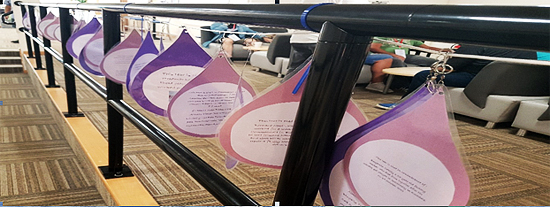NW BT Unions Health & safety Co-ord Secretary John Southwell reports on what is for Union Safety Reps , the event of the year - the annual Hazards Conference.
John attended the weekend conference from Friday 27th July:
The Hazards Conference is the UK’s biggest and best educational and organising event for trade union safety reps and activists. It consists of a mixture of plenary sessions, meetings and a comprehensive workshop programme. Delegates have the opportunity to exchange experience and information with, and learn from, safety reps
and activists from other unions, sectors and jobs across the UK.
Firstly, I would like to thank Blackburn TUC, Openreach & my Branch for allowing me to attend Hazards again this year.
I arrived at Keele University late Friday afternoon to register at 19.30 we met in the Westminster Theatre for the opening plenary. On the top table were, Steve Tombs, Asli Odman, D Russell, Louise Taggert & Janet Newsham.
Doug Russell opened by talking about the fact that it was the 40th anniversary of safety reps, also the 30th anniversary of the Piper Alpha disaster & that it has been a year since the horrific fire at Grenfell Tower in London.
A beautiful glass window has been made to remember those who have passed away at work it will go on display at a permanent location soon. The chair then thanked everyone who had organised this year’s Hazards, for all their hard work over the past few months, including Hilda Palmer & Janet Newsham.
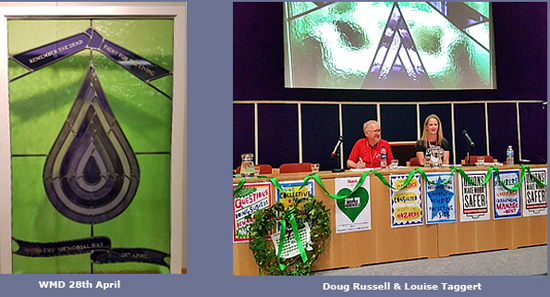
Louise Taggart
(FACK) then got to the lectrurn & spoke about her brother Michael Taggert, he was killed at work, Louse has done a video of her brother’s storey & it is a very moving one!
“Michael’s been in an accident in Dundee. We’re on our way to the hospital.”
Those were the words my mum said to me on the evening of 4th August 2005.
Assuming it was a car accident, I didn’t ask, during the brief call, what had happened to Michael.
Later that evening, I kissed my wee brother’s forehead and said goodbye for the last time as he lay dead in a hospital bed, with barely a scratch on him.
He hadn’t been in a car accident – he’d been electrocuted at work.
Michael was an experienced spark, 26-years-old and engaged to be married. It had never for one minute crossed my mind prior to his death that he might leave for work one morning and not return home. Yes, of course electricity is dangerous, but it can – and should – be worked with safely…shouldn’t it?
He had cut a cable marked ‘NOT IN USE’, which was in fact wired into a distribution board and was not safely isolated. It took more than three years for the case against the company that employed him to get to court, and for us to find out the fundamental failings in implementing safe systems of work that led to Michael’s entirely preventable death.
The HSE press release issued after the trial outcome said: “Michael Adamson’s death could have been prevented had his employer ensured that safe working practices were being carried out in accordance with the company’s own written procedures.”
Asli Odman
then took to the lectern. She mainly works on the concretization of labour practices and capital accumulation processes in urban spaces, thus on 'production of space by human agency'. The period that Ms Odman has mostly worked on is in the inter-war period. Ford Motor Company's global history so far facilitated me to pursue this way of 'entangled history'.
This historiographical approach pushes her toward sociological field studies mostly in industrial, precarious and/or informal districts and sectors in İstanbul. Observing Istanbul leads me further to topics like working people's health and precarity. Therein the sector I mainly focus on is the shipbuilding industry where there have been many workplace deaths.
Every day at least 20 to 30 people die due to work related reasons ( accidents, deadly occupational diseases or suicides) in a workforce of around 23 million. Unemployment is 11%. Only a small fraction of those work-related deaths are registered.
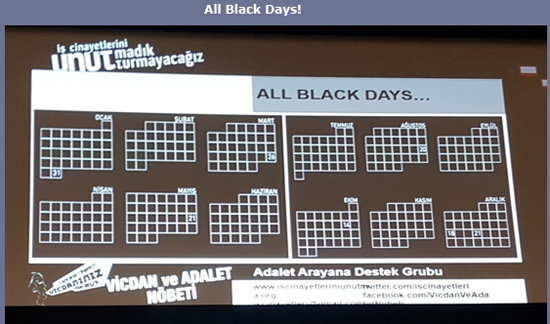
Boxes with the date of month recorded are the good days, for these are the days no-one died!
There are many vigils in Turkey to remember those who have died at work.
Steve Tombs
Spoke about Grenfell Tower fire in London. This “disaster” was nothing less than social murder! Sadly, it’s becoming quite normal as global dearth rate is equivalent to two Grenfell’s a day! Seven people have been prosecuted who were LIVING in Grenfell; no-one has been prosecuted over the massive H & S failings, fire safety failings within the building or local authority (one of the wealthiest in the UK!) failings a year on!
The harm caused is almost immeasurable, not only the deaths of course but the harm to the survivors, those who were injured, the fumes & gasses breathed in, PTSD, the phycological harm they appear to have been treated with utter contempt! The contractor saved £293,000 by using the cheaper cladding, although the residents were promised homes not one of them has yet to receive a permanent home over a year down the line. In 1830 the factory’s act was fought for by the working people, NOT given by the government & it must not be allowed to be dismantled & taken away from them!
Saturday 28/07/18. 09:00am
Time for our first workshop, William Coats Fire Risk inspections.
There were twelve in our session, and Mr Coats gave us his background, he is a retired fire fighter & has undertaken many roles whilst within the fire service. He said that if the fire brigade have to turn up to a fire there has been a failure as it’s their job to prevent fires in the first place!
If a workplace has more than five employees a fire risk assessment (FRA) is needed. This should be on show & be a live document & reviewed every three months. A good FRA will have within it, the Hazard, Harm, you Evaluate, Record & Review
HHERR
A corridor should have a sub-division every twelve meters, a building does not have to be evacuated if the false alarm can be identified & one person informs those in charge that he/she is responsible for the false alarm. The “lobby approach” system is in use in Scotland, so with that & other changes implemented over a decade ago now Grenfell Tower could not have happened in Scotland. Vision panels in fire doors should NOT be covered up! If you are a safety rep it is a good idea to find out the name of your local fire safety enforcement officer! The FSEO for Lancashire is Lister Haworth.
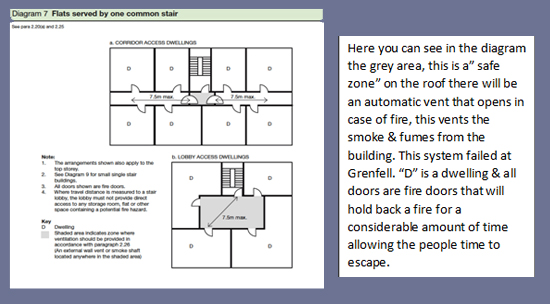
Saturday 28/07/18 11:00 am
Working with our Prospect colleague’s we studied how was the best way to get enforcement to work for us as safety reps. There were five tables of three people & we worked together to come up with the answers to a scenario.
Our scenario was that our employer was at the early stages of planning a large re-development of one of its properties in an office block. It intendeds to carry out the work while staff are in the building, there is asbestos in the building & the members are, quite rightly, concerned about this.
They were afraid of scaremongering & had the full confidence that they already knew how to handle/manage any asbestos found in the building. In activity one we were told that an H & S inspector would be visiting & that we will get the opportunity to talk to him/her in private. What information do we bring to the inspector’s attention?
Activity 1
We would gather as much data as we could, inform the inspector of any concerns the staff may have, if there was any lack of co-operation from anyone? Also give our contact details out & build a good working relationship, get out the best biscuits with the tea/coffee etc! Look at the next steps & agree a way forward that would benefit all party’s!
Activity 2
If negotiation is not working what route to resolve the problem? Think about the brown book (SRSC regs) & the rights, by law, you have as a safety rep. Also, what communications could you send?
Our answer was to use;
Reg 7 allows for inspection of documents. Reg. 5 allows for the inspection of the workplace.
Reg 37 4a allows consultation of reps. Reg. 38 allows full risk assessment consultation.
Escalate all issues up to the H & S committees, use collective action as a TU, use specialist knowledge of any members who have this. Also, to use social media, leaflets, e-mails, stalls/stands & meet staff/members off site if necessary. Fully promote what you are doing.
One of the ladies on my table wrote out on a flip board at the front of the class & I presented all our findings/data & information to the class.
28/07/18 14:00 – 15:45
Is mental health a consequence of the intensification of working practices?
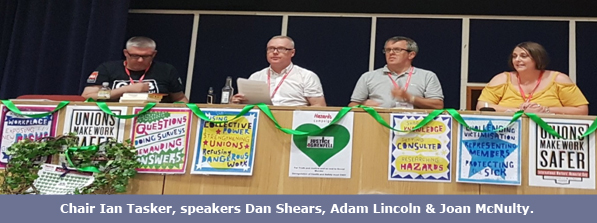
The chair opened by talking about the Clydesdale Bank & how they targeted the low skilled workers first, then the messengers, he then introduced Dan Shears, the first of our speakers.
Dan Shears
Spoke about the lack of an evidence base for the intensification of work causing more mental health issues among the workforce, that there were lots of different figures gathered in many different ways! There is also a lack of regulations regarding mental health, metal heath first aiders were a good thing if this was done correctly!
Any inspections do not cover mental health issues, zero hours contracts need to be scrapped; all our TU H & S reps need to be doing something about mental health issues & for it to be added to all safety committee’s agenda’s.
Adam Lincoln
Adam is the bargaining and Negotiations Official (Health, Safety and Sustainability) with the UCU. He said that a firm grip on contracts & working hours was needed, this is a large issue for his members. Employees no longer in control of their time at work & to some degree nor are the managers with the increasing use of technology within company’s! They had created a “work load rep” who (among his/her existing duties) was to consult with members on workloads, they were given the facilities to do this by the company.
You need to, ID & appoint a rep, train them & give them an action plan & schedule any events/issues to be dealt with, set up a joint working group. Use this evidence to construct a risk assessment & agree a way forward.
Joan McNulty
Joan spoke about the work of carers & the abuse they suffer from “clients”. In many cases this happens on a daily basis, the environment (the clients home) must be put on forms so a better picture can be gained for the environment that the carer is going to enter.
It is clear that violence and abuse are key issues in social care but it is difficult to give an exact indication of prevalence or trends in the number of incidents experienced by staff. Figures range from 93% of staff experiencing verbal abuse through to 56% experiencing physical abuse. Suffice to say, the majority of staff involved in the research across the board had experienced some form of violence or abuse in their current position. There is some evidence that staff working with people with learning disabilities and autism, with dementia, with mental health problems and with substance misuse issues are more likely to be at risk than other staff.
However, this is based on limited data so should be treated with caution. In addition, there is concern that lone workers and personal assistants may be at more risk as they lack the back up of other staff.
28/07/18 16:00 – 17:30
Banishing asbestos from our workplaces & communities.
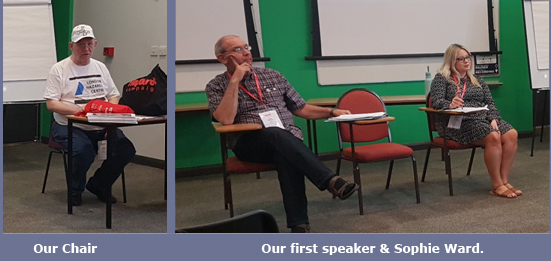
London Hazards has been helping the victims of asbestos & all its related diseases since 2002, some women contracted mesothelioma simply because they washed their husbands work overalls! Compensation for suffers of Plural plaques is still given in France but not the UK.
The government has funded DR Beth Taylor to look at the effects of mesothelioma, a report I would like to see when completed. If victims cannot find insurance to cover there is a scheme in place to help them. The unique achievements of Mrs Mavis Robinson were recognised in the New Year’s Honours List with the award of an MBE (Member of the Order of the British Empire) for her outstanding work assisting UK asbestos victims and their carers. Working as a Macmillan Nurse in the 1980s-1990s, Mavis saw more and more cases of a purportedly rare cancer called mesothelioma.
Unfortunately, what Mavis was witnessing in Leeds back then was the tip of the iceberg; while, the number of cases of mesothelioma was increasing nationally, the incidence of this disease in hotspots such as Armley, Leeds was wreaking havoc on the local population, many of whom had worked at or lived near the J. W. Roberts Co. asbestos textile factory.
Harminda Bains Leigh Day
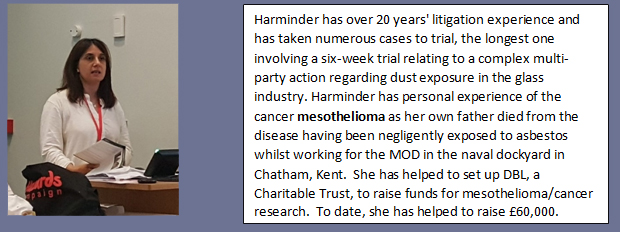
Clients with mesothelioma are getting younger, one was only in her 50’s who worked for M & S, if you have been exposed you must go to your GP & get it registered with them, tell your employer & find out who their liability insurer is. A number of important documents are about to be destroyed by a company in an important case that is in progress now, a judge is holding them at the moment & Harminda is hopeful that these documents will not be destroyed.
The US still use asbestos & it is still not banned, although it is no longer mined the American industry still legally imports, uses & sells asbestos products. Many Americans mistakenly believe that asbestos was banned decades ago!
Sophie Ward
A shocking figure is that 86% of schools in the UK still contain some form of asbestos! Sophie, who is a policy officer from the National Education Union (NEU), which is part of the Joint Union Asbestos Committee (JUAC) told our workshop that around 86% of schools in England contain some form of asbestos.
“Blue and brown asbestos were banned in the 1980s, but white asbestos was only banned in 1999, so any school that was built before the year 2000 could contain asbestos,” said Ms Ward.
“The problem is that in many cases the asbestos is decades old and in a deteriorating condition and when asbestos is in a poor condition, it’s more likely to release asbestos fibres.
There is a high risk for children and teachers alike!
“It’s particularly concerning for pupils,” she added. “The condition that is associated with asbestos exposure is called Mesothelioma, and it’s a cancer of the lung and stomach lining. It is wholly associated with asbestos exposure and it’s fatal. It also has a very long latency period of between 10 and 50 years. The younger you are when you are exposed to asbestos, the more at risk you are of developing Mesothelioma in later life.
“If a child is exposed at the age of five, they have five times greater risk than an adult exposed at the age of 30. The epidemiologist Professor Julian Peto has estimated that every year between 200 to 300 adults die because they were exposed to asbestos at school.”
In terms of school staff, Ms Ward said HSE records show the number of teachers dying from Mesothelioma is increasing. In 1980, she said it was average of three a year, but now it’s an average of 18. Action that is need needed now;
“The first thing the government needs to do is undertake a full audit of all schools and colleges, ascertaining the location and condition of asbestos, so it has the full picture of the scale of the problem,” said Ms Ward.
“The Government then needs to use that information to start the removal of all asbestos in school, and prioritise which schools have asbestos in the most dangerous conditions.”
Ms Ward added the JUAC would also like to see the HSE reclassify schools, which are currently rated as low risk and reinstate proactive inspections, looking at asbestos.
Lastly, it was good to see my safety friends & colleagues again this year, Hilda Palmer, Allan Mc Shane, John Murphy, Tony Pedal & Stephen Thomas to name just a few!
References:
Flats image from: The building regs dot org. Accessed 30/07/18 16:57
http://cms.thebuildingregulations.org.uk/document-section/means-of-escape-from-flats/
